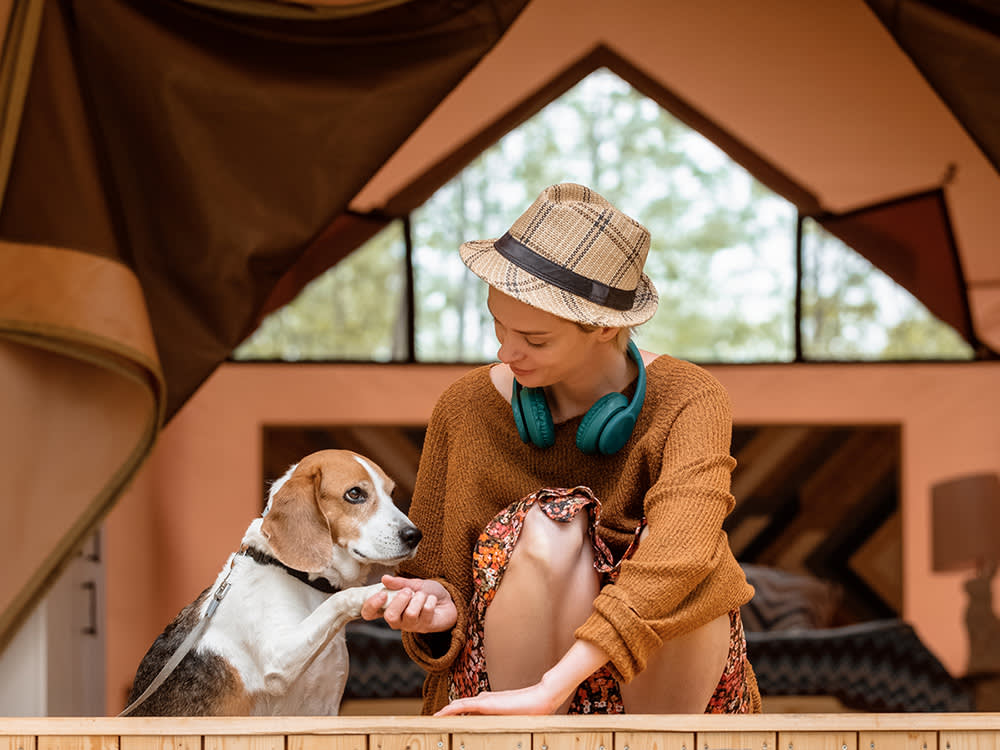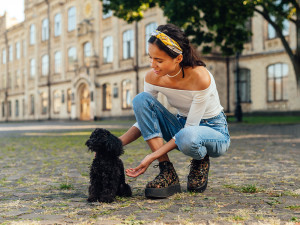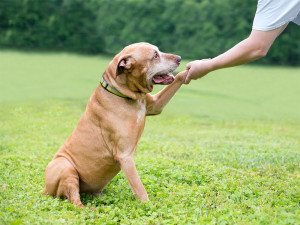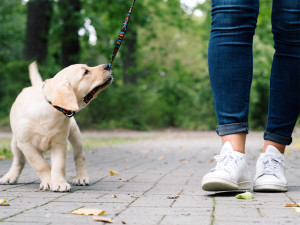Is ‘Shake’ a Bad Word For Your Dog to Learn?
Uh, who else got that memo?

Share Article
Earlier this summer, I brought my two-year-old Aussie, Miley, to an outdoor bar with some friends. When the waiter approached us to take our orders, she did what most dog-friendly people do: she asked if Miley could have a T-R-E-A-T. “Sure,” I said, and before I knew it, Miley’s left paw was nestled in her right hand. I, being the one who taught Miley to shake, was proud – that is, until two of my friends broke into a conversation about how they purposely didn’t teach their dogs to shake. After a little bit of back-and-forth, my pride turned into embarrassment and, shortly after that, shame.
When did ‘shake’ become a no-no? Did it deserve its seemingly new bad rap? And, more importantly, should I stop using it? For the sake of my own pride, I had to find out.

littleKin™ is Kinship’s home just for puppy and kitten parents. Bop over to check out expert advice, new pet tools, and special deals—all curated for your newest family member.
opens in a new tabA little bit of history
‘Shake’, as a command, has been around for a very long time, but it wasn’t up for debate until semi-recently. In the ’80s and ’90s, dog trainers taught tricks for consistent and impressive conduct – but without a strong grasp of canine behaviour and learning theory (how a dog processes and retains knowledge), says Kim Roche, a dog trainer and behaviour consultant. It wasn��’t until the 21st century that trainers became educated in learning theory and could truly understand the power of a certain command, she says. As such, most have stopped teaching it. But why?
The problem with ‘shake’
“‘Shake’ is a really cute trick, and so it’s often one of the first people teach their dog,” says Jamie Hansen, dog trainer and owner of Diamond Hill Dog Trainingopens in a new tab. “People love the contact and interaction with a dog through a human gesture.”
The issue is that cute can quickly turn ugly, warns Roche. “‘Shake’ is usually a harmless trick, but I have seen it go wrong,” she says, recalling stories of dogs knocking tea out of someone’s hands or whacking a child in the face. That risk is inherent in the trick because “we know now that any behaviour we teach a dog through positive reinforcement will almost always occur spontaneously, too,” says Roche. This means that unless you’re living with a trained service dog or you’ve done a lot of work on stimulus control, your dog will probably extend its paw in hopes of getting a treat or a handout in moments you don’t want them to.
It’s a slippery slope, says Roche. “If we teach a dog to shake, we’re teaching them ‘Go ahead and put a paw on a person.’ For most dogs, it’s incredibly hard to know that one is OK but two isn’t, and before you know it, you have an otherwise great dog jumping when that’s not an encouraged behaviour,” she explains.
Someone could get very hurt.
For your dog – particularly if you have a shy one – ‘shake’ could also invite distress, adds Roche. Your pup might be cool with being touched in one context but not another; and bringing strangers into the mix (often the case with the ‘nice-to-meet-you’ shake trick) could put them on edge and result in a not-so-welcoming reaction.
Shaking off ‘shake’
That’s not to say you can’t or shouldn’t teach your dog to shake – your dog, your decision. Don’t let anyone’s opinion or judgement (note to self: not even your friends’) dissuade you from something you feel good about.
“All that matters is your personal tolerance – do you care if your dog paws when you don’t want them to?” asks Hansen.
If you do care, you can stop asking for a shake and just reinforce a nice sit. But you can also teach your dog an even cuter, less problematic trick, says Hansen: the wave. It’s a little harder to teach, she notes, but it 1) removes the contact, and 2) takes more effort for your dog to execute, so they’re less likely to do it unprompted.
To teach it, Hansen says, you’ll first need your dog to learn how to sit on their hindquarters. From a sit position, hold a treat over their head and get them to stretch a little from their hind legs.
Next, have them hold this stretched position for a few seconds (keep giving them treats – they’ll really have to use those muscles), then show them how to wave one of two ways. Either take their paw and raise it up, giving them a treat as you say the word ‘wave’. Or, if your dog is pretty sharp, you can wave yourself, saying the word until they try it on their own.
As for me and Miley? We’re slowly casting out the word shake, but we haven’t quite gotten a hang of the whole wave thing yet. I’m confident, though, that we’ll get there. And when we do, everyone – waiters, friends and myself included – will be not only proud, but impressed.

Marissa Gainsburg
Marissa Gainsburg is a writer, editor and content strategist who recently traded East Coast humidity for West Coast waterfalls (and wildfire smoke). She lives in Portland, Oregon, with her thru-hiker boyfriend (how cliché) and their freakishly intelligent Aussie, Miley. She previously covered all things wellness and lifestyle as the features director at Women's Health. Her work has also appeared in Cosmopolitan, SELF, and Men's Health.
Related articles
![A senior Retriever/Terrier mixed breed dog shaking hands with its owner.]() opens in a new tab
opens in a new tabHow to Teach an Old Dog New Tricks
Your senior dog might move slower these days, but that doesn’t mean they can’t learn new things
![woman gives small black dog treat for sitting]() opens in a new tab
opens in a new tabYour Dog Should Do This 30-Day Training Challenge
It’s like your 30-day yoga challenge – except with way more training treats
![Stylish woman sitting on a bench with her Boston Terrier dog.]() opens in a new tab
opens in a new tabHere’s Why Your Dog Is Terrified of New People
And how to change it
![Woman sitting in a cafe with her dog.]()
Can Your Shy New Rescue Dog Become a Social Creature?
With patience and positive reinforcement, you can do a lot to make up for lost time with socialisation
![Golden retriever puppy chewing and pulling on lead as pet parent tries to walk them]() opens in a new tab
opens in a new tabHow to Tackle Common ‘Pandemic Puppy’ Issues
Turns out, humans weren’t the only ones affected







